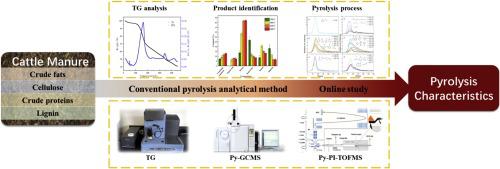当前位置:
X-MOL 学术
›
J. Anal. Appl. Pyrol.
›
论文详情
Our official English website, www.x-mol.net, welcomes your
feedback! (Note: you will need to create a separate account there.)
Pyrolysis study on cattle manure: From conventional analytical method to online study of pyrolysis photoionization time-of-flight mass spectrometry
Journal of Analytical and Applied Pyrolysis ( IF 5.8 ) Pub Date : 2020-10-01 , DOI: 10.1016/j.jaap.2020.104916 Sirong He , Congcong Cao , Jinglan Wang , Jiuzhong Yang , Zhanjun Cheng , Beibei Yan , Yang Pan , Guanyi Chen
Journal of Analytical and Applied Pyrolysis ( IF 5.8 ) Pub Date : 2020-10-01 , DOI: 10.1016/j.jaap.2020.104916 Sirong He , Congcong Cao , Jinglan Wang , Jiuzhong Yang , Zhanjun Cheng , Beibei Yan , Yang Pan , Guanyi Chen

|
Abstract Cattle manure is a kind of abundant agriculture waste but potential renewable resource to be converted into fuel by pyrolysis. The pyrolysis behavior of cattle manure was analyzed by three methods in this work: thermogravimetric analyzer (TG), pyrolysis-gas chromatography/mass spectrometry (Py-GC/MS) and pyrolysis photoionization time-of-flight mass spectrometry (Py–PI–TOFMS). The pyrolysis process of cattle manure included four stages, dehydration stage, lignocellulose decomposition stage, lignin and protein decomposition stage, char and mineral matter decomposition stage. The products were mainly classified into six groups: ketones, aldehydes, phenolic compounds, acids, hydrocarbons and N-containing compounds. Based on the time-evolved profiles and temperature-programmed profiles, the characteristics of these major products were analyzed and discussed. Maillard reaction has great effects on the pyrolysis process of cattle manure because cellulose can easily react with protein to produce abundant Amadori products and then generate cyclopentanes and furanmethanol. In addition, some Amadori products and amino acids can also be cyclized to generate N-heterocycle compounds like pyrroles and pyrazines. The decomposition of lignin basic units with more methoxy groups require higher reaction temperature, and the removal of hydroxy and methoxy group on phenols mainly occurred at around 350 °C. Furthermore, primary decomposition pathways of cattle manure were also proposed and discussed.
中文翻译:

牛粪热解研究:从常规分析方法到热解光电离飞行时间质谱在线研究
摘要 牛粪是一种丰富的农业废弃物,但具有通过热解转化为燃料的潜力的可再生资源。本研究通过三种方法分析牛粪的热解行为:热重分析仪(TG)、热解-气相色谱/质谱(Py-GC/MS)和热解光电离飞行时间质谱(Py-PI-)。飞行时间质谱)。牛粪的热解过程包括脱水阶段、木质纤维素分解阶段、木质素和蛋白质分解阶段、炭和矿物质分解阶段四个阶段。产品主要分为六类:酮类、醛类、酚类化合物、酸类、烃类和含氮化合物。基于时间演化曲线和程序升温曲线,对这些主要产品的特点进行了分析和讨论。美拉德反应对牛粪的热解过程有很大影响,因为纤维素很容易与蛋白质反应生成丰富的阿马多利产物,进而生成环戊烷和呋喃甲醇。此外,一些 Amadori 产物和氨基酸也可以环化生成 N-杂环化合物,如吡咯和吡嗪。具有较多甲氧基的木质素基本单元的分解需要较高的反应温度,酚类上羟基和甲氧基的去除主要发生在350℃左右。此外,还提出并讨论了牛粪的初级分解途径。美拉德反应对牛粪的热解过程有很大影响,因为纤维素很容易与蛋白质反应生成丰富的阿马多利产物,进而生成环戊烷和呋喃甲醇。此外,一些 Amadori 产物和氨基酸也可以环化生成 N-杂环化合物,如吡咯和吡嗪。具有较多甲氧基的木质素基本单元的分解需要较高的反应温度,酚类上羟基和甲氧基的去除主要发生在350℃左右。此外,还提出并讨论了牛粪的初级分解途径。美拉德反应对牛粪的热解过程有很大影响,因为纤维素很容易与蛋白质反应生成丰富的阿马多利产物,进而生成环戊烷和呋喃甲醇。此外,一些 Amadori 产物和氨基酸也可以环化生成 N-杂环化合物,如吡咯和吡嗪。具有较多甲氧基的木质素基本单元的分解需要较高的反应温度,酚类上羟基和甲氧基的去除主要发生在350℃左右。此外,还提出并讨论了牛粪的初级分解途径。具有较多甲氧基的木质素基本单元的分解需要较高的反应温度,酚类上羟基和甲氧基的去除主要发生在350℃左右。此外,还提出并讨论了牛粪的初级分解途径。具有较多甲氧基的木质素基本单元的分解需要较高的反应温度,酚类上羟基和甲氧基的去除主要发生在350℃左右。此外,还提出并讨论了牛粪的初级分解途径。
更新日期:2020-10-01
中文翻译:

牛粪热解研究:从常规分析方法到热解光电离飞行时间质谱在线研究
摘要 牛粪是一种丰富的农业废弃物,但具有通过热解转化为燃料的潜力的可再生资源。本研究通过三种方法分析牛粪的热解行为:热重分析仪(TG)、热解-气相色谱/质谱(Py-GC/MS)和热解光电离飞行时间质谱(Py-PI-)。飞行时间质谱)。牛粪的热解过程包括脱水阶段、木质纤维素分解阶段、木质素和蛋白质分解阶段、炭和矿物质分解阶段四个阶段。产品主要分为六类:酮类、醛类、酚类化合物、酸类、烃类和含氮化合物。基于时间演化曲线和程序升温曲线,对这些主要产品的特点进行了分析和讨论。美拉德反应对牛粪的热解过程有很大影响,因为纤维素很容易与蛋白质反应生成丰富的阿马多利产物,进而生成环戊烷和呋喃甲醇。此外,一些 Amadori 产物和氨基酸也可以环化生成 N-杂环化合物,如吡咯和吡嗪。具有较多甲氧基的木质素基本单元的分解需要较高的反应温度,酚类上羟基和甲氧基的去除主要发生在350℃左右。此外,还提出并讨论了牛粪的初级分解途径。美拉德反应对牛粪的热解过程有很大影响,因为纤维素很容易与蛋白质反应生成丰富的阿马多利产物,进而生成环戊烷和呋喃甲醇。此外,一些 Amadori 产物和氨基酸也可以环化生成 N-杂环化合物,如吡咯和吡嗪。具有较多甲氧基的木质素基本单元的分解需要较高的反应温度,酚类上羟基和甲氧基的去除主要发生在350℃左右。此外,还提出并讨论了牛粪的初级分解途径。美拉德反应对牛粪的热解过程有很大影响,因为纤维素很容易与蛋白质反应生成丰富的阿马多利产物,进而生成环戊烷和呋喃甲醇。此外,一些 Amadori 产物和氨基酸也可以环化生成 N-杂环化合物,如吡咯和吡嗪。具有较多甲氧基的木质素基本单元的分解需要较高的反应温度,酚类上羟基和甲氧基的去除主要发生在350℃左右。此外,还提出并讨论了牛粪的初级分解途径。具有较多甲氧基的木质素基本单元的分解需要较高的反应温度,酚类上羟基和甲氧基的去除主要发生在350℃左右。此外,还提出并讨论了牛粪的初级分解途径。具有较多甲氧基的木质素基本单元的分解需要较高的反应温度,酚类上羟基和甲氧基的去除主要发生在350℃左右。此外,还提出并讨论了牛粪的初级分解途径。











































 京公网安备 11010802027423号
京公网安备 11010802027423号